10 Free Gap Analysis Templates in Excel, Word, & ClickUp
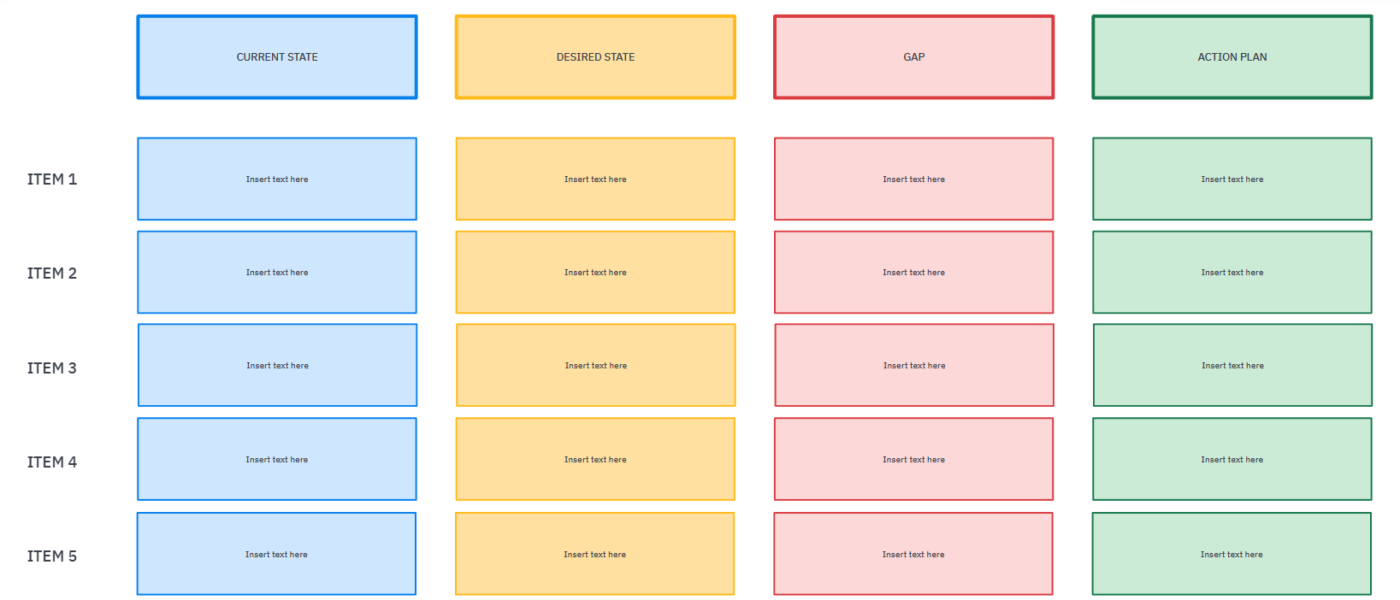
Sorry, there were no results found for “”
Sorry, there were no results found for “”
Sorry, there were no results found for “”

A gap analysis goes by many names—efficiency tracker, needs assessment, or variance analysis.
By understanding where gaps exist in a system, organizations can take steps to bridge the gap and move closer to reaching their goals. Gap analysis templates provide an easy way for businesses to gain insight into what needs improvement and develop strategies for success.
They can also serve as a starting point for mapping out process changes or developing new products and services. With gap analysis templates, businesses have an effective tool for tracking progress and ensuring accountability throughout the process.
It might seem like a Herculean task designed for change agents like business analysts to tackle. But with gap analysis templates, anyone is prepared to make fundamental moves in strategic, product, people, and process improvements!
We’ve put together a list of gap analysis templates in ClickUp, an all-in-one productivity tool that makes it easy for teams and businesses across industries to provide feedback, communicate, and work alongside each other. But we’ve also included the best Excel and Word gap analysis templates to consider!
For context, a gap analysis is a process of identifying and evaluating the differences between the actual performance of an organization’s asset and its desired state.
A gap analysis template breaks down complex problems to make informed decisions, build actionable plans, and increase productivity.
As your organization grows—employees are promoted, department key performance indicators (KPIs) are towering, and internal resources are depleting—the key is getting down to the details to take swift action.
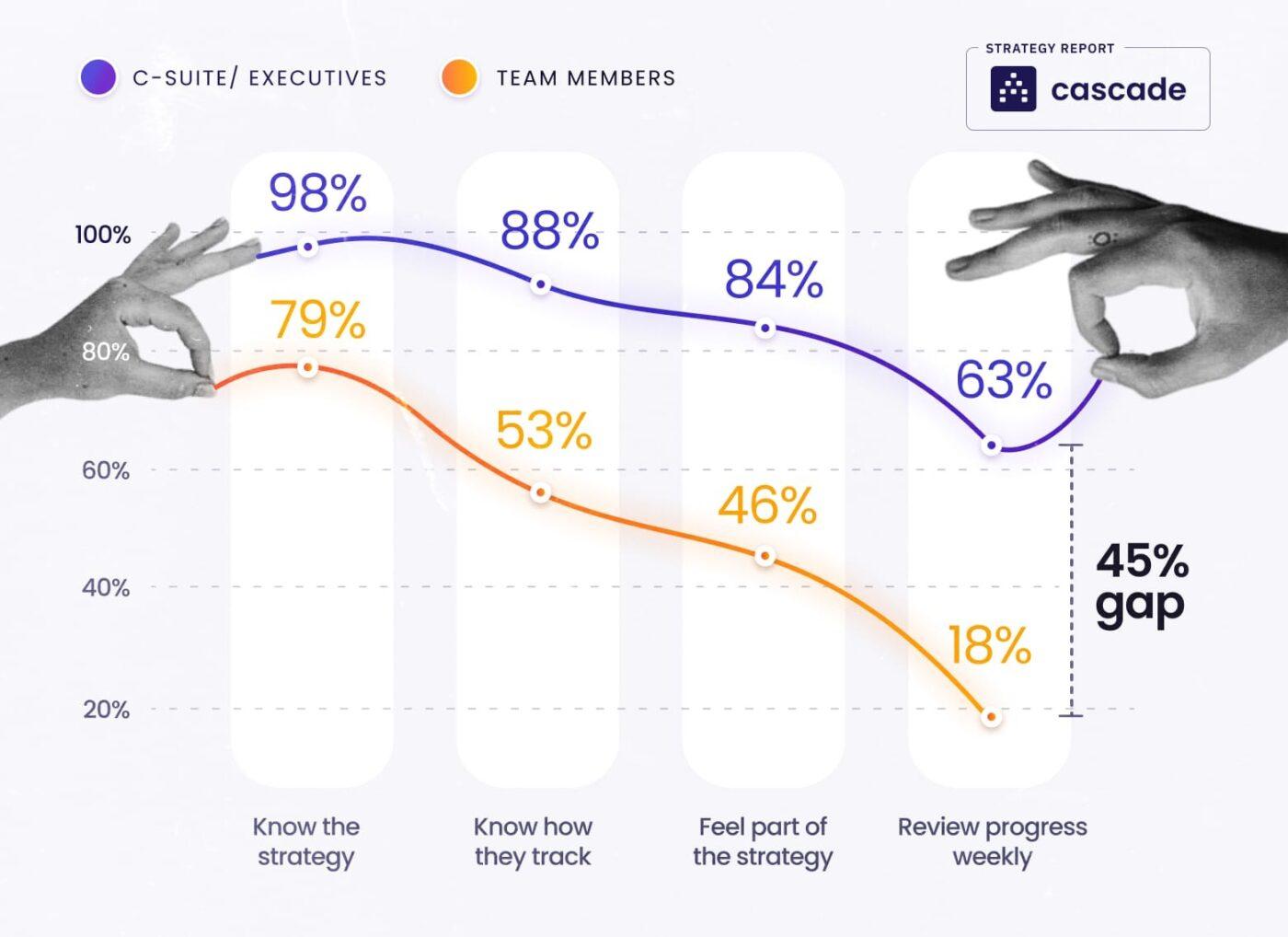
Discover SWOT analysis templates!
A good gap analysis template supports different types of content, such as text, images, videos, and links, to tell the whole story. It should be flexible for any analysis contributor to easily add or remove elements so that your analysis has the data to support your research.
It’s entirely possible to do without a gap analysis template, but you should reserve the time you’re spending on prepping the analysis for the actual analysis work:
Gap analysis templates come in various formats—documents, lists, tables—all of which we’ve included in our template roundup. They speed up the creation process and help organize information into structured categories so audiences can understand the data without confusion.
Competitive analysis is a vital part of any business strategy—especially when you’re launching a new service or product. It’s the process of researching your competitors and understanding what they have to offer so that you can stay ahead of the game.
ClickUp’s Competitive Analysis Template does just that and more! This template helps you:
Whether you’re launching a new product or growing an existing one, ClickUp’s Competitive Analysis Template gives you everything you need to make sure your business succeeds!
Prioritizing skills begins with assessing the skills gap that currently exists in each employee. You can do it through a skills audit, and once this is complete, you can prioritize which skills require immediate help.
Along with your assessment, sort your tasks by priority to see the most important tasks in your workflow and add time estimates to plan accordingly.
This is easy to do with the ClickUp Priorities Skills Gap Analysis Template! It shows you a list of all team members grouped by priorities with their department, skill name, rating, total score, target score, action steps, performance gap, and priority level.
There are four levels of Priority in ClickUp: Urgent, High, Normal, and Low. How you define and use each Priority in a skills gap analysis is your choice! Here are standard priority benchmarks for inspiration:
Strategic planning tools in the ClickUp Gap Analysis Template will help represent the group’s thinking and drive better conversations! Everyone can build on each other’s contributions in a low-pressure environment.
This beginner-friendly ClickUp Whiteboard template covers any strategic focus areas—policies, profit, product, or existing processes—to turn ideas into actionable tasks. The flexibility of this template (an infinite canvas) gives the team space to develop a thorough understanding of the gaps getting in the way of a focus area reaching its full potential.
Use these simple ClickUp template tips to fast-track your gap analysis process:
Finding markets with more demand than supply is done through the technique of product gap analysis. This is a great approach for businesses to take advantage of underserved markets and identify the goods and services that are in demand but aren’t readily available.
Product gap analysis is an vital tool for any product team. It allows you to identify weaknesses in your products and prioritize features to stay competitive in the market. But organizing, collecting, and analyzing data can be a complex and time-consuming process.
ClickUp’s Product Gap Analysis Template helps make it easier by helping you:
With ClickUp’s Product Gap Analysis Template, you can get the insights you need—fast—to stay ahead of the competition!
If you need to look at the skill gaps as a whole team, switch to the Department List view in ClickUp’s Skills Gap Analysis Template! This tool will help you assess your current staff’s expertise and experience to determine the necessary skills for a high-functioning team.
Use this template to research industry hiring trends and gather feedback from your team and executive leadership. Once these specific skills are identified, you can compare them with the existing skills and identify recruitment or training initiatives to fill those gaps.
By taking the time to prioritize skills, organizations can ensure they are well-positioned for success today and in the future!
Learn how staff training and development can help the bottom line!
A skills gap analysis analyzes the skills of an organization’s existing workforce compared to the skills required to meet its current and future goals. This type of assessment identifies skills gaps that need to be addressed for an organization to move forward with its business objectives.
Once skills gaps are identified, organizations may offer employees training programs and other learning opportunities to help them develop the skills they need. Organizations may also hire additional employees with the required skills or outsource work when expertise isn’t available internally—or if teams are at their workload capacity.
Use the ClickUp Skills Gap Analysis Template to help centralize all your team members grouped by skill type with their department, skill name, rating, total score, target score, action steps, gap, and priority level. The target score defaults to 0 being the lowest and 25 the highest, but you can customize this score to your preference!
Learn how to manage the capacity planning process!
Skill mapping is a process used to identify skills and knowledge gaps within an organization or workforce. By assessing the skills of individuals, organizations can gain insight into their employees’ abilities to fill skills and knowledge gaps. Skill mapping involves analyzing skills, abilities, and qualifications against job requirements and identifying discrepancies.
Skill mapping also helps organizations increase productivity by ensuring that employees are well-suited for their roles and have the opportunities to perform their best work. When employees have the right skills for their roles, it encourages collaboration between teams, streamlining processes, optimizing resources, and improving overall organizational performance!
The ClickUp Skills Mapping Template has pre-formatted Custom Fields to begin rating your team’s skills: Leadership, Communication, Time Management, Problem Solving, Computer Skills, Data Analysis, Technical Writing, and Project Management.
Bonus: Competitive Analysis Templates
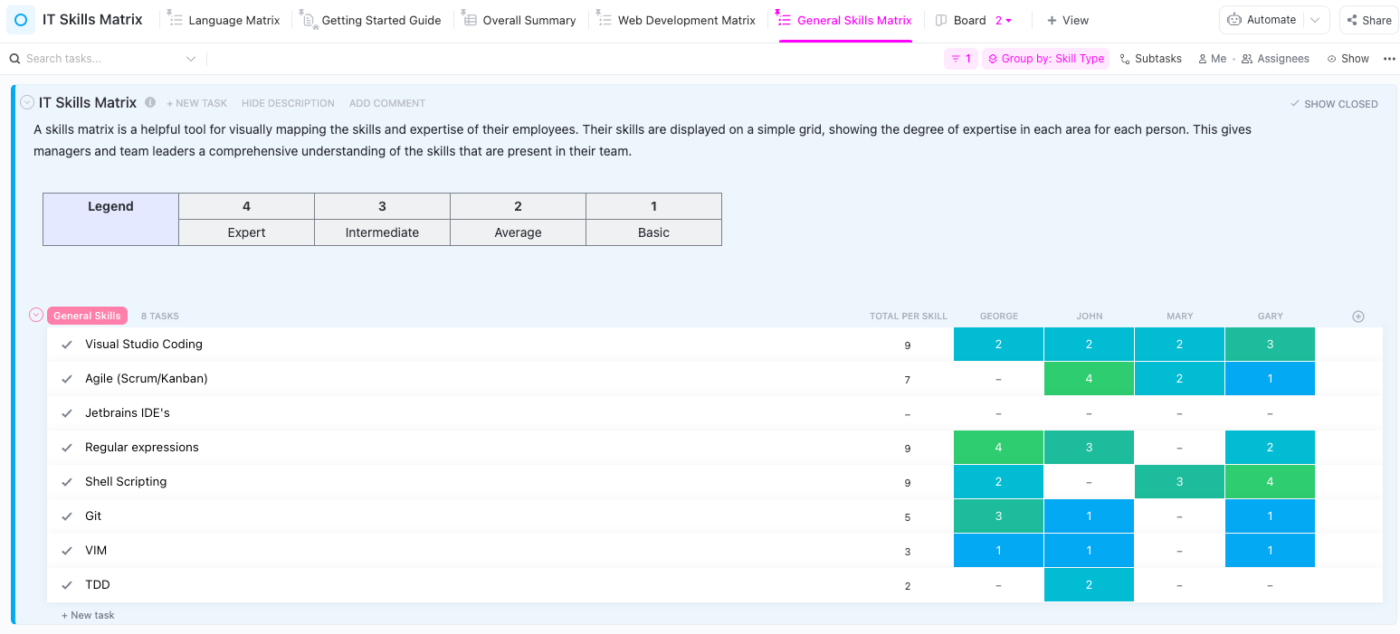
A skills matrix, also known as a skills inventory, is a tool used to assess and track the skills of an individual or a team. It visually represents employees’ qualifications, skills, and abilities concerning the skills required for performing specific job roles. It’s a reference point tool for managers to assess employees’ skills gaps and plan training sessions accordingly.
Moreover, it helps employers align their staff with various business objectives more effectively by ensuring that individuals complete all relevant tasks efficiently.
The General Skills Matrix in ClickUp includes a Legend scale you can use as a starting point in your skills gap analysis:
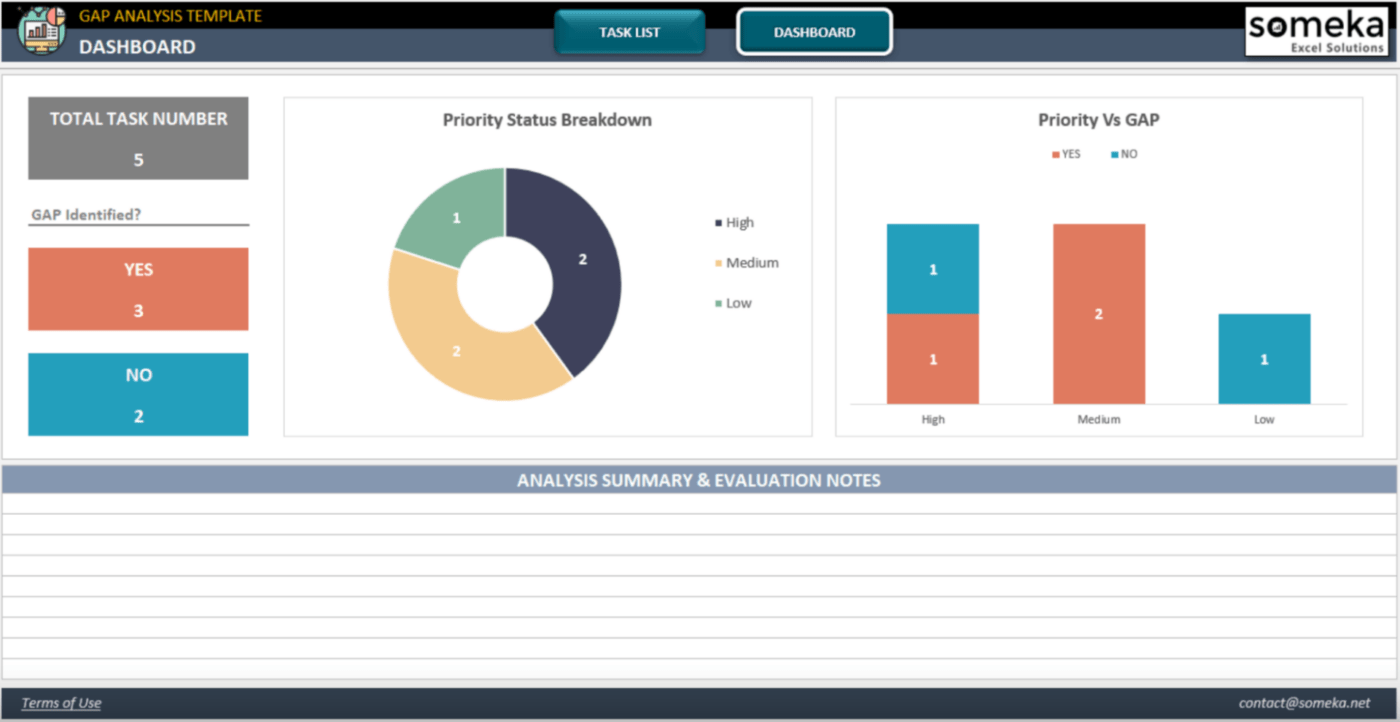
At first glance, this gap analysis template might look overwhelming, but its done-for-you structure and design will help you outline your goals and objectives for any gap analysis process!
The main features in this template are:
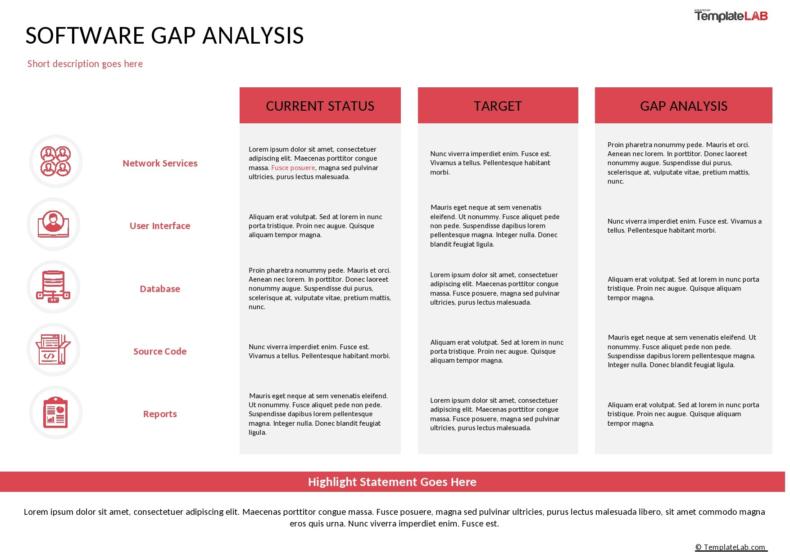
This free gap analysis template in Word is specifically designed for software assessments. Although it’s not a template built to be a working document (like capturing tasks or notes), you can quickly swap out the placeholder text with your content, make a few color tweaks, and share with executive leadership.
The gap analysis document template has three primary columns: Current Status, Target, and Gap Analysis. At the bottom, there’s a space for a highlights statement.
Before using a one-page template, we recommend you use a ClickUp template to perform the work in a gap analysis. So let’s walk through how to perform a gap analysis!
Your task is made clear.
Perform a gap analysis to answer the question: Why aren’t we meeting specific goals, and what’s the plan of action?
Okay, that’s two questions, but this step-by-step guide will help you answer both!
Establishing clear goals and objectives is essential before beginning a gap analysis. This stage aims to list exactly what the organization hopes to achieve in the end, and this will provide a benchmark for comparison later in the process.
In this step, it’s essential to assess how well the organization performs compared with its desired goals. This includes collecting data from multiple sources, such as customer feedback surveys, internal audits, and financial reports. Then, you should evaluate this data against established standards or benchmarks for comparison purposes.
Once all relevant data is collected and analyzed, it’s time to evaluate any existing problems preventing the organization from achieving its goals. Analyzing both strengths and weaknesses at this stage helps identify areas that need improvement or further development within the organization, like its processes, systems, or resources, which you can address later in the process.
Utilize these root cause analysis templates!
After identifying potential areas of improvement, set Specific Measurable Attainable Realistic Time-Based (SMART) goals that will assist in attaining higher levels of performance through strategic planning initiatives that are achievable within given deadlines or timelines.

With defined objectives and measurable targets established, develop an action plan detailing solutions. This plan involves a communication strategy and reaching out to any key team members necessary to make changes run smoothly.
Once the implementation is complete, monitor progress periodically against pre-determined benchmarks and targets. The key to long-term success is actively assessing changes’ effectiveness while regularly evaluating results achieved on an ongoing basis.
After going through this process, you can confidently conclude a successful gap analysis exercise!
A gap analysis template is a valuable tool that can benefit anyone looking to evaluate their current state and identify areas for improvement. This makes it useful for a wide range of individuals, businesses, and organizations. Check out these templates to see if they can help you reach your goals:
Marketers: Whether you’re a small business owner or part of a marketing team, a gap analysis template can help you assess your current marketing strategies and identify areas for improvement. By identifying gaps in your target market, messaging, or tactics, you can create a more effective and targeted marketing plan.
Project Managers: Keeping track of project progress and identifying potential roadblocks can be a daunting task. A gap analysis template allows project managers to compare current performance metrics with desired outcomes, making it easier to identify areas for course correction and improvement.
A gap analysis template in ClickUp lowers the barrier to entry for you to get past the blinking cursor and get on a fast track to actionable solutions. You’ll save time breaking down complex problems to make informed decisions, build actionable plans, and increase productivity.
ClickUp offers a feature-packed Free Forever Plan to focus on the needle-moving work and save one day a week. Create an account today!
© 2025 ClickUp